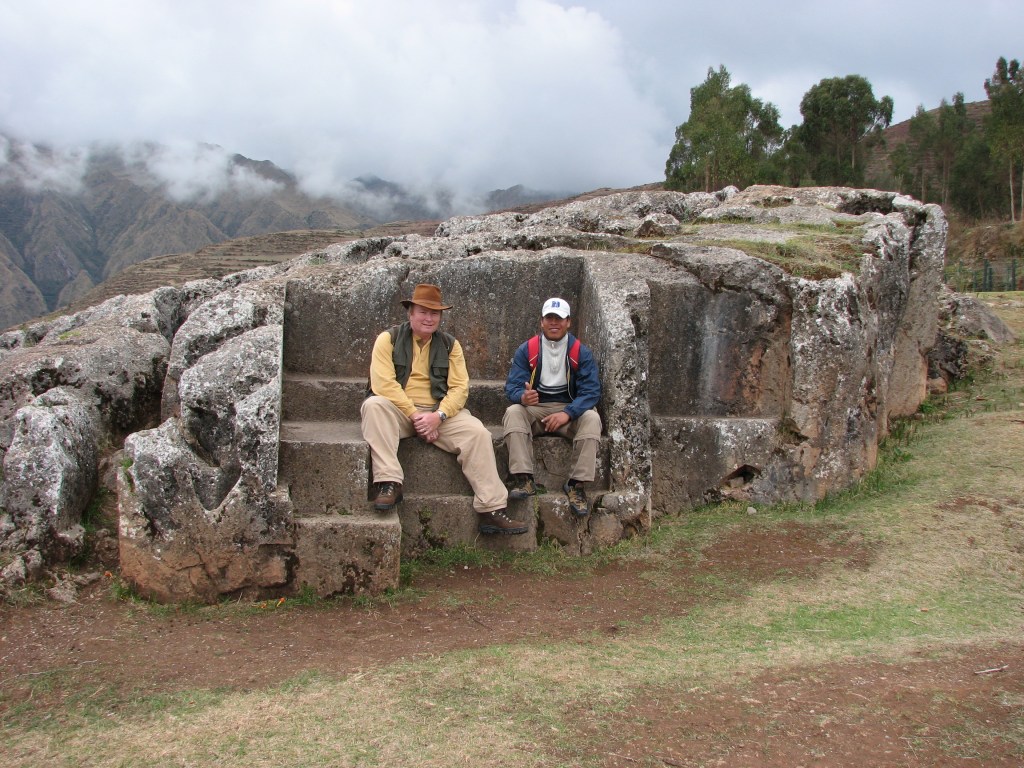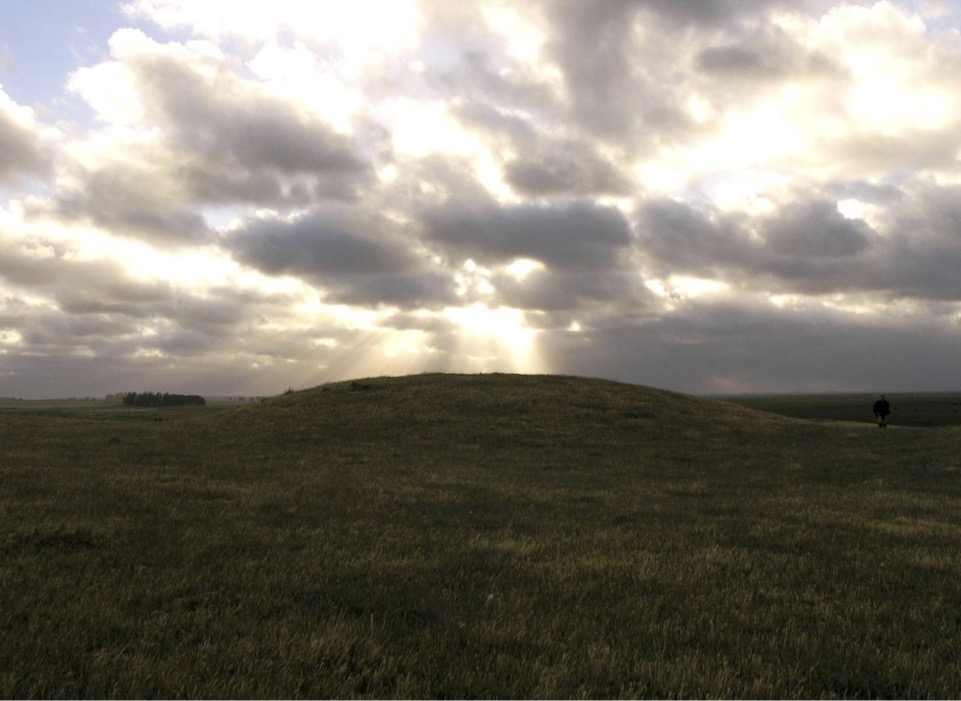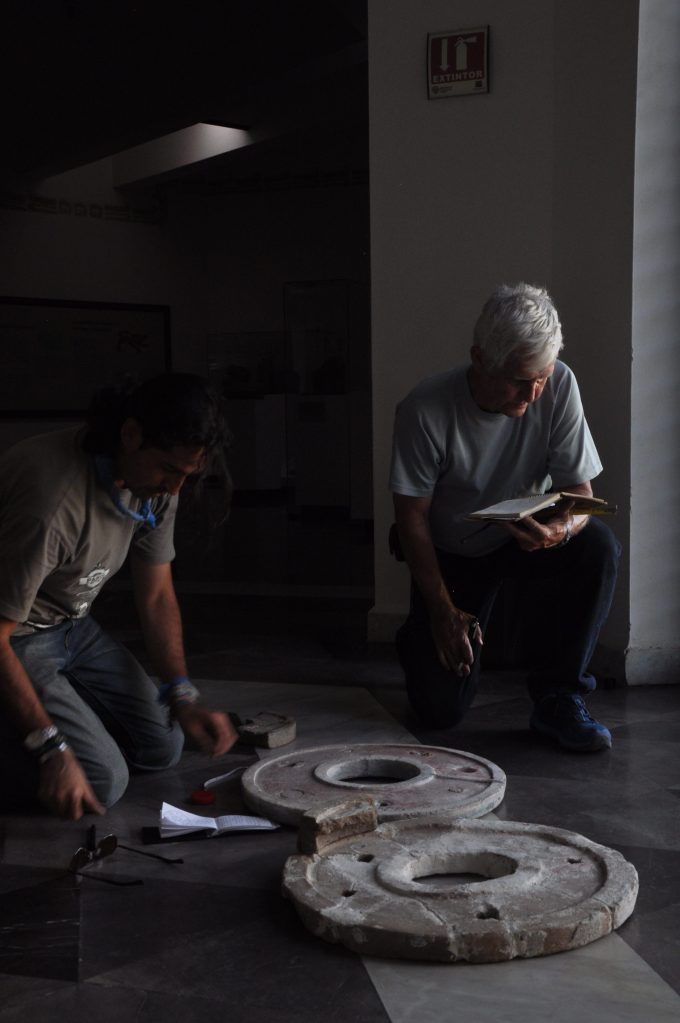The Deep Roots Of Astronomy In Latin America
By observing the cosmos, Indigenous peoples precisely measured natural phenomena like solar eclipses, leap years, and El Niño.

At a solar observatory in the Maya city of Xochicalco, in Mexico, sunlight passed through a disk at ground level and shined down a long hole into a cavern below, allowing observers to track the sun’s location throughout the year. This image shows how one beam of light enters the cavern on April 29, the first day light enters in non-leap years. Credit: KL Murphy
This story was produced by Science Friday and América Futura as part of our “Astronomy: Made in Latin America” newsletter and series. It is available in Spanish here.
For thousands of years, people across Central and South America looked to the sky to keep track of time and the seasons. In studying the movement of celestial bodies, some also found dark spots in our galaxy.
“The Incas saw not just the kind of constellations that we see—they also saw dark constellations in the dark patches in the Milky Way,” says Dr. Steven Gulberg, an astronomer at the University of Oklahoma.
Dark constellations are made up of several giant interstellar dust and gas clouds that block light in the center of the galaxy and can only be seen in the Southern Hemisphere. Gulberg remembers his Peruvian colleague Carlos Aranibar Huaman using a green laser to point out each constellation and tell its story.
“The procession started with the Mach’acuay, the serpent,” Gulberg recalls, followed by Hanp’atu, the toad, and Yutu, the partridge. The most important constellation is Yacana, which is made up of two llamas, a mother and her baby. At the end of the procession of stars is Michig, a shepherd who protects the two llamas from Atoq, a fox. Gulberg acknowledges that despite having completed a doctoral degree, he had never heard of dark constellations, and says that learning their stories in the Andes was one of the most memorable experiences of his life.

Studying the cosmos has been a fundamental part of humans’ quest to understand how their lives relate to the world. In pre-Columbian Latin America, observations of the universe helped different groups predict weather changes, keep track of the seasons, and develop accurate calendars. They also inspired philosophical and religious ideas. Studying astronomical observations of the past helps us better understand these societies’ ingenuity and sophistication.
The Incas weren’t the only ones to see dark constellations in the Milky Way. Some Indigenous groups in Uruguay and southern Brazil saw a rhea, a large flightless bird native to South America, in those dark spots. Today, in the area they occupied, there are some 3,000 human-made mounds, known locally as “cerritos de indios” or Indian mounds. Researchers believe that many were built using the dark constellations of the Milky Way.
These earthen mounds are located in wetland plains that are easily flooded. They allowed their builders to protect their homes and crops, and even provided a place to bury their dead. The mounds are also believed to be some of the first structures dedicated to observational astronomy built by humans in South America.
“What is most striking is that they do not show up scattered about, but rather they show up in groups,” explains Dr. César González-García, an astronomer at the Institute of Heritage Sciences in Spain. He says one thing that stood out to him and other researchers is that when they would stand on top of a mound, they would always see another one appear as a bump on the horizon, which led them to wonder if they might have had “something to do with the sky.”

To answer that question, a research team took measurements of the mounds and found that they were aligned with the rising of the new moon before and after the winter solstice, and the rhea constellation seen in the dark patches of the Milky Way.
González-García believes the earthen mounds helped observers determine “certain climatic and animal movement cycles,” which allowed these groups to negotiate time and space thousands of years ago.
Pre-Columbian stargazers didn’t only study the night sky. In Central America, they also observed the sun and its position to develop sophisticated calendars.
“In practically all Mesoamerican peoples, we are going to find day counters who watch the stars and watch the sun,” says Dr. Rubén Bernardo Morante López, an anthropologist at the Universidad Veracruzana in Mexico.
Morante López explains that these peoples studied the movements of the celestial bodies to accurately predict rainy seasons and the best times for planting, and to plan various ceremonial events. For example, the Maya used two 365-day solar calendars and could even predict eclipses hundreds of years before they occurred.
To carry out some of their observations, several societies built underground solar observatories. Morante López has studied more than 20 such observatories in parts of Mexico and Central America, including one at Xochicalco, a Maya city in Mexico built around the year 700. This solar observatory is similar to the telescope used by Galileo Galilei in 1612 to see sunspots. But instead of using lenses to magnify the sun’s image, it uses a disk with five holes—a large one in the center and four smaller ones around it—atop an inverted “chimney” to project sunlight down into a cavern.

The chimney is a deep, narrow hole, and when the disk was in place on top of it at ground level, sunlight shone into the cavern for 105 days each year, from April 29 to August 13. The light passed through one of the small circles on the first day, and more appeared gradually through the others. All five circles of light appeared at the bottom of the cavern on only two days: May 14 and July 29. On the last day of the cycle, only the circle opposite the first one was projected, and for the rest of the year, the cavern remained in darkness. Every four years, on April 29, no sunlight was projected into the cavern, which meant that the system would automatically add a day to the calendar in leap years.
A great deal of Indigenous astronomical knowledge was lost with the arrival of the conquistadors and the Spanish Inquisition. “The first to be persecuted are the leaders, those who are spreading the worship of the ancient gods,” Morante López explains. According to him, the Spaniards had no interest in the knowledge used in Indigenous agriculture, which was regulated by calendars and astronomy.
However, not all of this knowledge disappeared. Evidence of early Indigenous observations can be found in archaeological sites, and traditional knowledge lives on in Indigenous communities throughout the continent. Some was also documented by chroniclers.
For example, in the Andes, the beginning of June’s planting season coincides with the appearance of the Pleiades star cluster in the sky. According to an account by the Jesuit Pablo José de Arriaga in 1621, when the seven sisters appear clearly and with no clouds in the sixth month of the year, the Incas predicted that it would be a bad year for crops in the empire. However, when Oncoy, the name they gave to this constellation, appeared blurry and with clouds around it, it was interpreted as a favorable time to start farming. Climatological and astronomical research has confirmed that there is a relationship between how these stars appear in the sky and the El Niño phenomenon, whose conditions reduce rainfall and increase the possibility of drought in the Andes.
This suggests that hundreds of years ago, through the observation of the stars, the Incas had found a way to detect temperature changes in the Pacific Ocean and anticipate their effects in the Andes. Today, rural Quechua and Aymara communities continue to use this observational method.
This story was translated from Spanish by Laura González.
Santiago Flórez is Science Friday’s community manager. He is a former teacher, anthropologist and journalist.